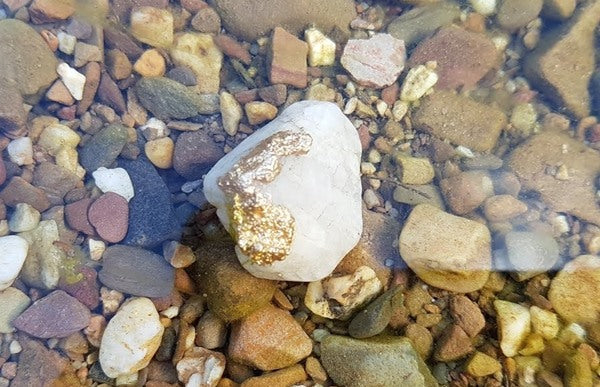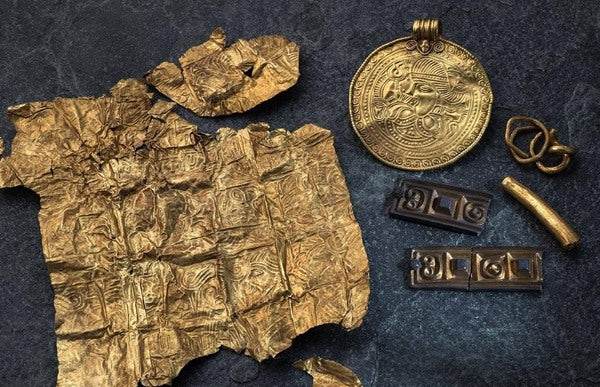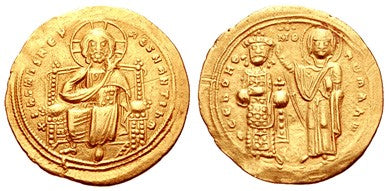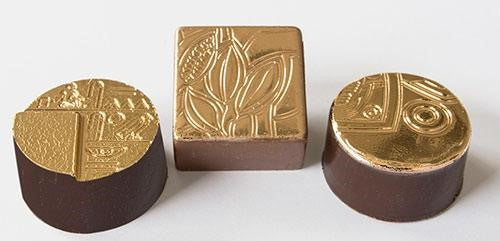Gold is Where You Find It
Posted on October 27 2019

Along with titanium, silver, and platinum, gold is considered to be one of the most valuable minerals ever to be found on our planet. Scarce, out of 94 naturally occurring elements, it's ranked 73rd in abundance. Historians believe that the Egyptians and Sumerians were the first to process and work with gold around 7,000 years ago. Gold is renown, not only for its attractive yellow, slightly reddish appearance but also for its remarkable physical and chemical properties. Gold is strong and resilient. Yet, unlike other metals, it's very flexible and does not react with other chemicals; it doesn't discolor, tarnish or crumble. Hence, the dense, malleable metal is both appealing to the eye and fairly easy to work with.
The mystery around gold's origins and how to recreate the formation process has been sought after information for millennia. That, however, did not become possible until many years later. Gold is considered an extraterrestrial element. First formed inside an interstellar “Supernovae” (collapsing star), it made its way to earth as space dust and meteorites over the past 4.5 billion years. When gold was first discovered by our hominid ancestors, it was in its natural form: tiny, gleaming yellow nuggets, which immediately captivated the beholder. Found in rivers and streams, it was the first metal known to our early ancestors. Since then, gold has been discovered on every continent and under the oceans. Seawater contains around ten micrograms per ton. Even our bodies contain about 0.2 milligrams of gold: most of it located in our bloodstream.

Gold can still be found in rivers. (Photo: YouTube - Gold and Relic Hunter 1958)
Gold in Norway
Gold can be found in several places in Norway. Many meaningful recoveries have been made in places like Eidsvoll, Bømlo, Svartdal, and Bindalen. However, it’s believed that no more than 500 kilograms of gold have been recovered in Norway. Smaller discoveries have been made in several rivers along Finnmarksvidda, and just like in Australia where prospecting for gold is quite a popular hobby. If one feels lucky, it’s still very possible to search Norwegian rivers and streams with a metal detector. One would think that many gold recoveries would be made from the Viking age like that in Buskerud. However, mostly silver has been recovered from this era. (793–1066 AD). The Vikings, much like the Egyptians, took great pride in dressing up and flaunting their wealth, using gold and silver.

The Gold Treasure at Tornes, discovered by Paul Norli, using a metal detector. (Photo: Åge Hojem, NTNU Science Museum)
The find, pictured above, is of one of the greatest Viking Era (793–1066 A.D) discoveries ever made. Found on the Tornes farm in Fræna (Møre and Romsdal, Norway), Paul Norli discovered it while taking an evening stroll with his metal dector. It was not only one of the greatest discoveries of his life but also the biggest one seen in Møre and Romsdal in over 40 years.
Mythology
Myths and folklore envelop gold, such as El Dorado, the lost city of gold, and King Midas, ruler of Phrygia, who was granted one wish: the golden touch. That, however, turned out to be more of a curse than a gift. All that he laid hands on instantly turned to gold: every piece of food, every person - one can only imagine.
The Aztecs believed gold to be the actual sweat of the sun, possible to harvest off the face of the land that they walked upon. It’s associated with God, wealth and holiness. The ancient Egyptians revered it, considering it to be the flesh of the gods. Not only was it a feast for the eyes, and a symbol of beauty, wealth and prosperity, but also used for magical protection. Hence, high ranking members of society were buried with it.

The Iconic King Tutankhamun's burial mask (Source: Getty Images)
Uses and Properties
Since ancient times and universally, gold has been highly sought after and used as currency. The first documented use of gold as currency was in 643 B.C in Lydia (modern day Turkey). By 560 B.C, they learned to separate gold from silver, creating the first ever pure gold coin. In 1861, the first U.S paper currency was printed and it was backed by gold. One could redeem their paper notes for gold at $20.67 per ounce. It's safe to say that a lot has changed since then.

Byzantine Gold Coins from 1034 AD, depicting Romanus III (1028-1034 AD). Photo by Ancient Resource
Gold is edible. Pure gold, containing 22 carats or more, and silver is safe to ingest (unless you have a rare allergy). In Asia they use a thin silver and gold filigree foil to cover sweets and other foods, making them appear more appetizing. Some of the most expensive chocolates, as well as some of the most expensive steaks, found today are presented with a thin layer of gold. This method is more commonly known as Varak.

Chocolate covered with gold foil (Source: Golden Innovations)
Yet, the primary use for gold is for jewelry: wedding rings, necklaces, bracelets and even teeth. The latter can be both for both appearance or health purposes since it won’t tarnish or break. It’s used in the production of chemical and electronic devices. It is an excellent conductor of heat and electricity in addition to being inert. It can be used as a plating on other metals, in a variety of electronic components, protecting against corrosion.
Gold is, as well as its many other properties an antioxidant and contains anti-inflammatory properties, finding applications in the world of skincare. Not only teeth prosthetics contain gold, but also leg and arm prosthetics as well. Nanoparticles from a radioactive gold isotope can be used as a part of chemotherapy and radiotherapy, treating arthritis and some forms of cancer that are otherwise difficult to reach. A condition called lagophthalmos, where one is unable to close one’s eyes fully, gold implants are placed into the eyelid to provide enough weight to help them close properly.
Gold is Eternal
Being one of the first metals ever discovered, gold has become a major component of the world's economy. It's unlikely to ever lose its value. Even if we have found ways to recreate the natural process in laboratories, it will remain too costly for generations to come due the intensive energy required. Gold will undeniably continue to be one of the most precious, offering numerous applications in finance, jewelry, art, medicine, skincare, and technology.
This story was written by Thea W Sørum and edited by Alexander Grover

